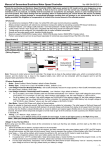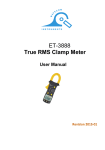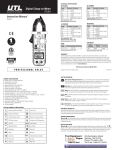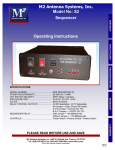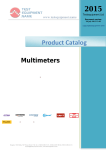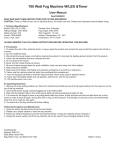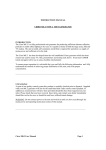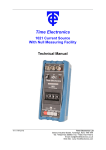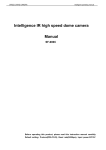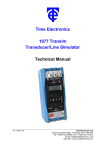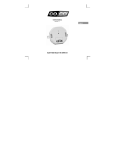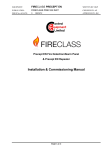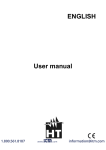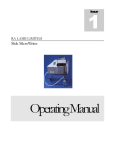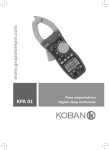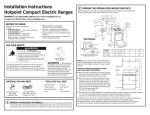Download OPERATING INSTRUCTION
Transcript
DIGITAL MULTIMETER MODEL: MS8233E Users Manual Table of Contents 1. Introduction 2. Safety note 3. Explanation of Controls and Indicators 3-1. Product illustration 3-2. Functional push button 3-3. LCD display 4. Specification 4-1. General Specification 4-1. Electrical Specification 5. Measurement operation 5-1 DC voltage & AC voltage measurement 5-2. Resistance measurement 5-3. Diode & Continuity check 5-4. DC/AC mA measurement 5-5. DC/AC 10A measurement 5-6. Temperature measurement 5-7 Detecting AC electric field 6. Maintenance 6-1. Replacing the battery 6-2. Replacing the fuse 6-3 Replacing the Test lead 6-4. Cleaning and Decontamination 1. Introduction This manual is used to MS8233E Digital Muti Meter only.. This Meter is a handheld and battery operated Digital Multi Meter(DMM) with multi function. This Meter is designed to meet IEC61010-1 & CAT II 600V over voltage category and double insulation. The meter with holster that is giving the main body, though downsized, high resistance against the shock of a drop. Protection provided by the instrument will be impaired if used in a manner not specified by the manufacturer. This operating instruction covers information on safety and caution. Please read relevant information carefully and observe all the warnings and note strictly. The DMM as general measurement tool and widely used in the school, laboratory, factory and other social field. 2. Safety note Warning To avoid possible electric shock or personal injury and to avoid possible damage to the meter or to the equipment under test, adhere to the following rule: Do not apply more than the rated voltage, of marked on the meter, between the input terminal and grounding terminal.. Do not apply voltage between COM and OHM terminal, in the resistance measuring state. Do not measure current with test lead inserted into voltage or OHM terminal. Do not expose the instrument to the direct sun light, extreme temperature and humidity or dew full. Inspect the test lead for damaged insulation or exposed metal. Before measuring current, check the Meter’s fuses and turn off power to the circuit before connecting the meter to the circuit. Disconnect circuit power and discharge all high voltage capacitors before testing continuity, diode, resistance, capacitance or current. 3. Explanation of controls and indicators 3-1. Meter illustration 10 Hazardous voltages in the test before measurement of what is known voltage to determine that determine that the equipment is functioning 1 correctly. Note international Electrical Symbol. 2 4 Dangerous Voltage Ground AC (Alternating current) Warning see explain in manual DC (Direct Current) Double insulation AC or DC Fuse 3 5 6 7 4 8 This product has been tested to the requirements ofC AN/CSA-C22.2 No. 61010-1, second edition, including Amendment 1, or a later version of the same standard incorporating the same level of testing requirements”. CONFORMS TO UL STD. 61010-1, IEC 61010-031 CERTIFIED TO CSA STD. C22.2 No. 61010-1 and 61010-031 Fig. 1 Exterior view -3 – ① ② ③ ④ ⑤ ⑥ ⑦ ⑧ ⑨ ⑩ LCD display “MAX” push button “BACK LIGHT” push button ‘HOLD” push button “FUNC” Push button Rotary Switch (Knob) “V/Ω/uA/mA/℃”Input terminal “COM” input terminal “10A” input terminal NCV indicator [LED] and ℃/℉. HOLD Press “HOLD” to enter and exit the hold mode in any mode. That act with trigger. MAX This key is act with trigger. Press this key once, the maximum value is holding (Will displays ‘MAX’ symbol in the LCD). After pressing the key, A/D will keep working, and the display value are always up dated and kept the maximum value. NOTE: The actual gained value is not the peak value. * -4- 3-2. Functional push button Push button Func Function “FUNC” key is the function select key that acts with trigger. Use the key as switch of DC/AC current, Diode/Continuity This key is used control Backlight. This key is act with trigger. When press and hold the key over 2 sec, will enable Backlight. Press the key again , the backlight will disable. -5- 3-3. Display indicators Number Indicator Meaning 1 DC voltage or current 2 AC voltage or current 3 Diode 4 MAX Maximum value 5 HOLD Data hold 6 7 8 9 10 Low battery indicator MKΩ Ω KΩ MΩ is unit of resistance ℃/℉ The unit of temperature (℃: Centigrade; ℉: Fahrenheit) µmVA mV ,V is unit of voltage µA, mA, A is unit of current 4.Specification Indicate negative reading ● Auto ranging DMM , that full scale is 2000 counts ● Display : 3 1/2 digit LCD display.. ● Over load protection: Used the PTC protection circuit for Resistance, temperature ● AC electric field detection function(NCV function) ● DATA HOLD function ● MAX value hold function ● Back Light ● Low battery indication -7- - -6- Fig. 2 LCD 4-1. General Specification ● Auto Power- OFF. : If the meter is idle for 15 minutes (idle time), the meter automatically turns the power off. After auto power-off, pushing any of the push button or changing the rotary switch can turn on the meter again. NOTE: (1) After auto power off in the AC mode, if changing the rotary switch to the DC mode, the Re-power on if disabled. (2) The meter enters sleep mode after quto power off. If press “HOLD” push button to re-power on in the sleep mode, the auto power off function is disabled. ● Operating temperature & Humidity: 0 ~ 40℃ (32 ~104 ℉) & < 80% RH ● Storage temperature & Humidity: -10 ~ 50℃ (14 ~ 122 ℉) & <70%RH ● Power Supply: 9V Battery(6F22 or 1604A Type) x 1pc. ● Safety Class: IEC 61010-1, CAT II 600V. ● Dimension (L x W x H) & Weight: 140 x 67 x 30mm, Approx. 112g Accessary: 1. K-type temperature probe[P3400]----2. User’s Manual ---------------------------3. Test lead ---------------------------4. 9V Battery --------------------------- 4-2. Electrical Specification 1pc 1pc 1set 1pc ( at 23±5℃; <75% RH) 4.2.1 DC Voltage Range Resolution 200mV 0.1mV 2V 0.001V 20V 0.01V 200V 0.1V 600V 1V Accuracy ±(0.5% rdg + 2dgt) * Over load protection: SG(Spark Gap) used to protect that the voltage overred 1500V 4.2.2 AC Voltage Range 2V Resolution (40Hz-400Hz) 0.01V 200V (40Hz-400Hz) 0.1V 600V (40Hz-200Hz) 1V ±(1.2% )rdg + 3dgt * SG(Spark Gap) used to protect High voltage that is over 1500V. 4.2.3 Resistance Range Resolution Accuracy ±(0.8% rdg + 2dgt) 200Ω 0.1Ω 2kΩ 0.001kΩ 20kΩ 0.01kΩ 200kΩ 0.1kΩ 2MΩ 0.001MΩ 20MΩ 0.01MΩ ±(1.0% rdg + 2dgt) 4.2.4 Diode check Resolution 0.001V -8- ±(0.9% rdg + 3dgt) 0.001V 20V (40Hz-400Hz) Range ±(0.8% rdg + 2dgt) Accuracy Function Will display the forward drop voltage. * Operating current:about 1mA * Open circuit voltage:about 1.48V -9- 4.2.5 Continuity Range Function If measured resistance less than 100Ω, will buzzer is sounded. * Open voltage: about 0.5V 4.2.6 DC Current Range Resolution 200µA 0.1μA 2000µA 1µA 20mA 0.01mA 200mA 10A Accuracy 4.2.8 Temperature You can selecting Centi-degree[℃] or Fahrenheit[℉] by “FUNC” key. Range Resolution -20℃ ~ 1000℃ 1℃ -20℃~0℃ (5% rdg + 4dgt) 0℃~400℃ (2% rdg + 3dgt) 0.1mA 400℃~1000℃ (3% rdg + 3dgt) 0.01A Fahrenheit Temperature [℉] ±(1.5% rdg + 3dgt) * Over Load protection:use the fuse(F250mA H 250V) at µA /mA range, and use the fuse(F10A H 250V) at 10A range. * Max input current::250mA at ‘mA’ input terminal and 10A at ‘10A’ input terminal.. . 4.2.7 AC Current [40Hz-400Hz] Range * Max input current::250mA at ‘mA’ input terminal and 10A at ‘10A’ input terminal.. . Resolution 200µA 0.1µA 2000µA 1µA 20mA 0.01mA 200mA 0.1mA 10A 0.01A Accuracy Range 0℉~1800℉ Resolution 1℉ Accuracy -0℉~50℉ (5% rdg + 4dgt) 50℉~750℉ (2% rdg + 3dgt) 750℉~1800℉ (3% rdg + 3dgt) Accuracy (1.5% rdg + 4dgt) * Over Load protection:use the fuse(F250mA H 250V) at µA /mA range, and use the fuse(F10A H 250V) at 10A range. - 10 - - 11- 5-2. Resistance measurement 5. Measurement operation 5-1 DC & AC voltage measurement Warning To avoid harms to you or damage to the meter from electric shock. Please do not attempt to measure voltage higher than DC/AC 1000V although readings may be obtained. The DC voltage range are 200.0mV, 2.000V, 20.00V , 200.0V and 600V and then. The AC voltage ranges are 2.000V, 20.00V, 200.0V and 600V. To measure DC or AC voltage: 1. Insert the red test lead into the “VΩ” input terminal and the black test lead into the COM terminal. 2. 3. Set the rotary switch to DC or AC range. Connect the test lead across with the object under testing. The measured value will be show on the LCD display. Note: When DC or AC voltage measurement has been completed, disconnect the connection between the testing lead and the circuit under testing. - 12 - The resistance range are: 200.0Ω, 2.000KΩ,20.00KΩ, 200.0KΩ , 2.000MΩ. 20.00MΩ. To measure resistance, connect the meter as follows: 1. Insert the red test lead into the ”VΩ” terminal and the black test lead into the COM terminal. 2. Set the rotary switch to proper resistance range.. 3. Connect the test lead across with the object under testing. The measured value will be show on the LCD display. Note: The test lead can add 0.1 Ω to 0.2 Ω of error to resistance measurement. To obtain precision reading in low-resistance measurement, that is the range of 200.0Ω, short the input terminal before measuring. In this time, the contact resistance displayed on the LCD. You can subtract the contact resistance value from the measured value. For high-resistance measurement (>10MΩ), it is normal taking several second to obtain stable reading. The LCD display “OL” indicating open-circuit for the tested resistor or the resistor value is higher than the maximum range of the meter. - 13 - 5-3. Diode/Continuity check . ① Set the rotary switch to “ ” NOTE: Input signal level must be higher than 0.5V (it is sensitivity). position. First time, default mode is diode check mode. You can enter the continuity check mode by the “ FUNC” Key. ② insert the red test lead into the “VΩ” terminal and the black test lead into the “COM” terminal. ③ Use the diode test mode to check diodes, transistors and other semiconductor device. In the diode test mode sends a current through the semiconductor junction, and the measure the voltage drop across the junction. A good silicon junction drop between 0.5V and 0.8V. ④ For forward voltage drop reading on any semiconductor component, place the red test lead on the component anode and place the black test lead on the component cathode. The measured value show on the display. ⑤ Reverse the test lead and measure the voltage across the diode again. If diode is good, the display shows “OL”. If diode is shorted, the display shows 0 (zero) in both direction. If display shows “OL” in both direction, the diode is open. 5-4. DC/AC µA or mA measurement DC Current range is 200.0µA/2000µA and 20.00mA,/200.0mA and then 10A range. AC Current range is 200.0µA/2000µA and 20.00mA,/200.0mA and then 10A range. 1. Turn off power to the circuit. Set the rotary switch to the properDC/AC µA or DC/AC mA position. 2. Break the current path to be tested. Connect the red test lead to the more positive side of the break and the black test lead to the more negative side of the break. 3. Turn on power to the circuit. The measured value show on the display. 5-5. DC/AC 10A measurement 1. Insert the red test lead into the input terminal marked as “10A”. 2. The measuring procedure is same as that of 5-5 section.. Note: Continuity Check: Press the “FUNC” key to enter to the continuity mode. ⑥ The buzzer sound if the resistance of a circuit under test is less than 100Ω. - 14 - For safety’s sake, the measuring time for high current should be ≤10 second for each measurement and the interval time between two measurement should be greater than 5 minutes. When current measurement has been completed, disconnect the connection between the testing lead and the circuit under test. - 15 - 5-6. Temperature measurement To measuring temperature shuld be use the K-type probe :P3400. 1. Set the rotary switch to the “TEMP” range. In this time, The environment temperature value displayed on the LCD. 2. Insert the K-type probe to the two “COM” and “TEMP” terminals. The two “+” and “-“ pins of temperature probe(P3400) must be direct at the “COM” & “ ℃”terminal respectively. 3. The measured temperature value will be displayed on the LCD. 5-7. Detecting AC electric field [ NCV function] The red LED on the upper area on the front panel lights up and then flickering at all function except for OFF when electric field excceding 90V is detected by the sensor that is incoporated in the inner upper area of front case. It indicates a presence of AC voltage in an electrical cricuit or equipment without touching them, i.e Non Contact Voltage detection(NCV). Detection against in-wall outlet is possible. The detecting position may be away about 20mm from the objet under check. - 16 - 6. Maintenance 6-1. Replacing the battery When meter display the battery must be replace to maintain normal operation. ① Disconnect and remove all test probes from any live source and meter. ② Open the battery cover on the bottom case by screwdriver. ③ Remove old battery and snap new one into battery holder 6-2. Fuse replacement Replacing the defective fuse should the done according to the following procedure. i. To avoid electrical shock, remove the test lead and any input signal before opening the bottom case. ii. Open the botton case and then remove the defective fuse and insert a new fuse of the same size and rating(F250mA H250V or F10A H250V). iii. Replace the bottom case and reinstall all the screw. 6-3. Test lead replacement The test lead has been used and replaced shall be comply with the requirements specified by the manufacturer in order to ensure operation safety,(1000v CATII or 600V CAT III 10 A or better) warning TO AVOID ELECTRICAL SHOCK, REMOVE TEST LEADS BEFORE OPENING BATTERY COVER. RISQUE DE CHOC ÉLECTRIQUE, RETIRER CORDONS DE MESURE D'OUVERTURE AVANT couvercle des piles. 6-4.Cleaning and Decontamination The meter can be cleaned with soft clean cloth to remove any oil, grease or grim. Do not use liquid solvent or detergent. - 17 -











